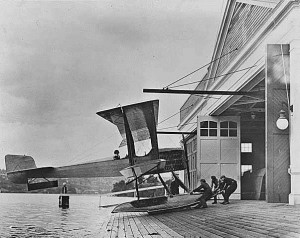14 Jan Boeing, Bertha, Billions
$166 Billion.
 That’s how much business revenue was generated by manufacturing inside the State of Washington in 2013. The number comes from the Washington State Department of Revenue from income reports that must be filed by every business for its operations within the state to calculate state tax liabilities.
That’s how much business revenue was generated by manufacturing inside the State of Washington in 2013. The number comes from the Washington State Department of Revenue from income reports that must be filed by every business for its operations within the state to calculate state tax liabilities.
To put $166 billion into context, it was more than all the in-state revenues reported in 2013 by all car and truck dealers, all grocery stores, all gas stations, all department stores, all restaurants, all bars, all theaters, all sports stadiums, all sports teams (including the Mariners and Seahawks), all software publishers, all internet publishers, all telecommunications firms (including those that are wireless), all computer service businesses, all law firms, all accounting firms, all architectural firms, all doctors’ offices, and all hospitals.
Combined revenues for those businesses totaled $140 billion.
The manufacturing revenue shows how the state’s industrial output helped speed the recovery from the Great Recession in 2009.
The revenue report also sets the stage for the 2015 Annual Meeting of the Manufacturing Industrial Council of Seattle.
Guest speakers for the meeting are Seattle Times publisher Frank Blethen; Boeing Commercial Airplanes VP Bill McSherry, and Todd Trepanier, program manager for the Alaskan Way Viaduct replacement project and its silent partner, “Bertha,” the deep-bore tunneling machine that is presently anything but boring.
The meeting will be held Tuesday, January 27, 3:30 to 5:30 p.m., in the auditorium at Colin Hall at the Georgetown campus of South Seattle College. Colin Hall is located in the southwest corner of the campus. Enter the parking lot at 6737 Corson Avenue. RSVP by emailingTory@box2063.temp.domains. Questions? Call 206-762-2470.
Here’s the lineup.
Blethen
Few families have spent more time trying to understand and explain Seattle than the Blethen clan. In 1896, Alden J. Blethen bought a publication that he turned into the Seattle Times. Today, the Times is among a dwindling number of family-owned, locally operated, independent newspapers left in the United States.
Since 1985, the newspaper has been the responsibility of publisher Frank Blethen, a passionate, opinionated, old-school news person who posts a tally of the paper’s nine Pulitzer Prizes on the front page of every edition. The Pulitzers reflect a willingness to invest in the journalism end of the news business. You might think that would be a given in the news industry. It’s not.
Once viewed by many as a conservative voice in Seattle, the paper has become as liberal as the community it strives to serve. Yet, under Blethen’s leadership, the editorial page is also steadfast in its support of the region’s industrial base.
For some “new” Seattle types, it might seem inconsistent for a liberal paper to support basic industry. What does Blethen think? Ask him.
At the MIC meeting, Blethen will address his concerns about the current state of education, and he will be available to answer questions about the ever changing political landscape of the city.
Boeing
A State of Boeing report will be provided by Bill McSherry, Vice President for Local and State and Global Corporate Citizenship for Boeing Commercial Airplanes. The working title for his presentation is, “Boeing in Washington – Our Future Together.”
That future began in 1916 when Bill Boeing founded Pacific Aero Products in a hangar on Lake Union. Nearly 100 years later, the future is still looking up.
Boeing employees delivered 723 commercial jetliners to customers during 2014.
Even with the much discussed expansion of production to South Carolina, nearly all those airplanes were produced within an hour’s drive of the Space Needle. The total included 485 737s assembled in Renton. The 2014 delivery rate worked out to an astounding 2.5 commercial jetliners every work day.
Aircraft deliveries were up more than 50% over five years ago. Financial impact was up, too.
Boeing Commercial Airplanes in Washington and in-state aircraft part producers accounted for $56.8 billion in gross business revenues in 2013. That was up 50% from $37.4 billion in 2009. The aircraft sector performance during that time was unusual, but not truly unique.
For instance, metal trades – a sector dominated by mom-and-pop metal fabricators and machine shops – also posted revenue growth of 50% during the same time period, with sales growing to $11.7 billion.
Overall, manufacturing revenue in Washington grew by 43% from 2009 through 2013, compared to 15% growth for the rest of the private sector.
That’s all great news. And nothing could ruin it faster than the Alaskan Way Viaduct.
The geologic clock is ticking and if it ticks wrong, the viaduct could be rubble faster than you can remember how many Es should appear in “Richter Scale.”
The election calendar is also moving forward. With all nine City Council positions appearing on the ballot in 2015, it is only a matter of time before the campaign revives for the “surface option” plan to tear down the viaduct and simply live without it.
Bertha
The Jan. 17th status report on the Alaskan Way Viaduct will be provided by program manager Todd Trepanier from the Washington State Department of Transportation. The news is not good due to Bertha’s stall. Trepanier’s update should prove timely given the cracks that are starting to appear in the viaduct partnership between the state, the city and the contractors.
Our bet is the billion-dollar fix will somehow keep moving forward.
A functional Interstate 5 is required to keep the state economy moving. That requires a replacement for the viaduct that accommodates as much through traffic as possible.
It would be hard to build 2 jetliners per day if I-5 is a parking lot and there is more commerce at stake than the aerospace sector.
Learn more at the meeting Jan. 27.
